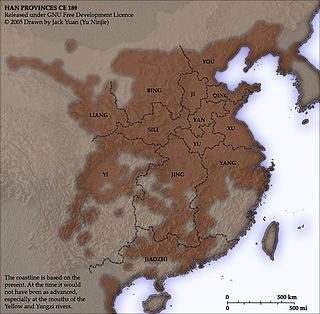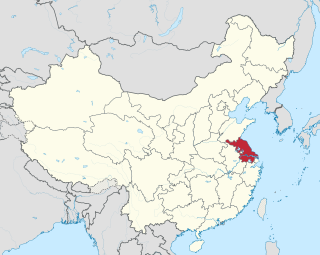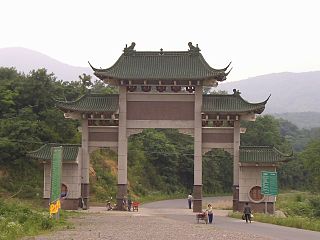
Liyang is a county-level city under the administration of Changzhou in the Jiangsu province of the People's Republic of China. In 2011, it had a population of about 781,500. It borders the prefecture-level divisions of Wuxi to the east, Xuancheng (Anhui) to the south, and Nanjing to the west.
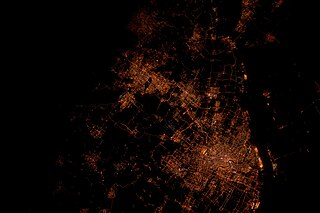
The Yangtze River Delta or YRD is a triangle-shaped metropolitan region generally comprising the Wu Chinese-speaking areas of Shanghai, southern Jiangsu province and northern Zhejiang province. The area lies in the heart of the Jiangnan region, where Yangtze River drains into the East China Sea. The urban build-up in the area has given rise to what may be the largest concentration of adjacent metropolitan areas in the world. It covers an area of 99,600 square kilometres (38,500 sq mi) and is home to over 115 million people as of 2013, of which an estimated 83 million is urban. If based on the greater Yangtze River Delta zone, it has over 140 million people in this region. Having a fertile soil, the Yangtze River Delta abundantly produces grain, cotton, hemp and tea. In 2018, the Yangtze River Delta had a GDP of approximately US$2.2 trillion, about the same size as Italy.
Jinshan can refer to places:
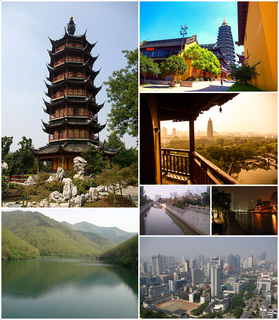
Changzhou is a prefecture-level city in southern Jiangsu province, China. It was previously known as Yanling, Lanling and Jinling. Located on the southern bank of the Yangtze River, Changzhou borders the provincial capital of Nanjing to the west, Zhenjiang to the northwest, Wuxi to the east, and the province of Zhejiang to the south. Changzhou is located in the highly developed Yangtze Delta region of China extending from Shanghai going northwest. The population of Changzhou city was 4,592,431 at the 2010 census.

Yizheng is a county-level city under the administration of the prefecture-level city of Yangzhou, Jiangsu province, China, with a population of about 600,000 (2007). It borders the prefecture-level divisions of Chuzhou (Anhui) to the north, Nanjing to the west, and Zhenjiang to the south.

Jingjiang is a county-level city under the administration of Taizhou, Jiangsu province, China. It is located on the northern (left) bank of the Yangtze River, and is the southernmost part of Taizhou City, bordering Nantong to the northeast, Suzhou to the southeast, Wuxi to the south, Changzhou to the southwest, and Zhenjiang to the west. The area of Jingjiang is 655.6 square kilometres and the population was 684,360 at the 2010 census.

Taixing is a county-level city under the administration of Taizhou, Jiangsu province, China. It is located in the Yangtze River Delta, bordering the prefecture-level cities of Nantong to the east, Changzhou to the southwest, and Zhenjiang to the west.

Runzhou District is one of three districts of Zhenjiang, Jiangsu province, China.
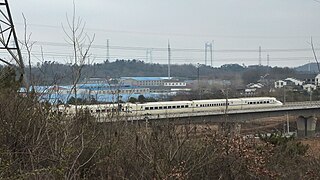
The Shanghai–Nanjing intercity high-speed railway or Huning intercity high-speed railway is a 301-kilometre (187 mi) long high-speed rail line between Shanghai and Nanjing, the capital of Jiangsu province. Hù and Níng are, respectively, shorthand Chinese names for Shanghai and Nanjing. The Huning intercity high-speed railway largely follows the route of the preexisting Nanjing-Shanghai section of the conventional Beijing–Shanghai railway and the Beijing–Shanghai high-speed railway. Construction of this high-speed railway began in July 2008. The line went into test operations in early April 2010, and opened for full service on July 1, 2010. The line has a design speed of 350 km/h (217 mph). The journey time between the two cities has been shortened from 120 minutes to 73 minutes on non-stop service.

The Shanghai–Chengdu Expressway, commonly referred to as the Hurong Expressway is an east-west bound expressway that connects the eastern metropolis of Shanghai to Chengdu, the capital city of Sichuan. The expressway passes through six provinces and serves major cities such as Suzhou, Wuxi, Changzhou, Nanjing, Hefei, Wuhan, and Yichang. The eastern terminus of G42 is at the Wuning Road Interchange of Shanghai Middle Ring Road. At its western terminus, the expressway intersects the East 3rd Ring Road and connects East Erxianqiao Road in Chenghua District, Chengdu. The expressway spans 1,960 km (1,220 mi) in length.

The Shanghai–Nanjing Expressway is a modern, enclosed, four-lane, two-way highway. Each lane is 3.75 metres (12.3 ft) wide, and the highway's roadbed is 26 metres (85 ft) wide. There is a 3-metre (9.8 ft) dividing strip in the center of the highway and a 2.5-metre emergency parking area on each side of the highway. The speed limit is 120 kilometres per hour (75 mph). It is 274 kilometres in length. It runs from Zhenru, Shanghai to Maqun, Nanjing via Anting, Kunshan, Suzhou, Shuofang (硕放街道), Wuxi, Changzhou, Danyang, Zhenjiang and Jurong. The Shanghai section is 25.87 kilometres in length, and the Jiangsu section is 248.21 kilometres long. The Zhenjiang section is 10.25 kilometres long. In Shanghai, the highway is coterminous with G2 Beijing–Shanghai Expressway and G42 Shanghai–Chengdu Expressway.
The 2012 Yangzhou earthquake occurred in Jiangsu Province of the People's Republic of China at 20:11 (UTC+8) in Yangzhou on July 20.
Yangzhou, Yangchow or Yang Province was one of the Nine Provinces of ancient China mentioned in historical texts such as the Tribute of Yu, Erya and Rites of Zhou.

The Shanxiang Mosque is a mosque in Runzhou District, Zhenjiang City, Jiangsu Province, China.

Zhenjiang dialect is a form of Eastern Mandarin spoken in the town of Zhenjiang in Jiangsu Province. The town is situated on the south bank of the Yangtze river between Nanjing and Changzhou. It is thus at the intersection of China's Mandarin and Wu speaking regions. About 2.7 million Chinese live in the area where the Zhenjiang dialect is predominant.
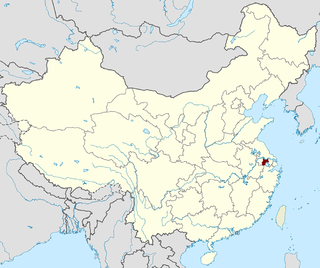
Changzhou or Chang Prefecture was a zhou (prefecture) in imperial China, centering on modern Changzhou, Jiangsu, China. It existed (intermittently) from 589 until 1277, when the Yuan dynasty renamed it Changzhou Route.
